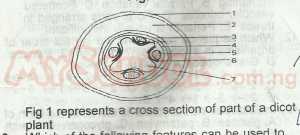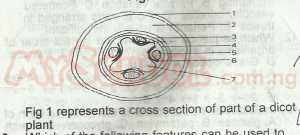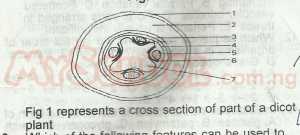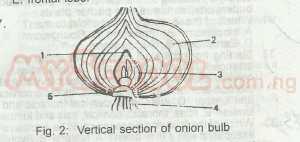Year :
1983
Title :
Biology
Exam :
JAMB Exam
Paper 1 | Objectives
41 - 50 of 50 Questions
| # | Question | Ans |
|---|---|---|
| 41. |
When spirogyra cell is immersed in a salt solution more concentrated than its cell sap, it A. Remains unchanged B. Takes up water an burst C. Absorbs a little water D. Loses water and shrivels E. Becomes turgid |
D |
| 42. |
Urea is produced in the A. Liver B. Bladder C. Spleen D. Kidneys E. Gall bladder |
A |
| 43. |
What is the genetic ratio of the F2 generation if members of F generation are allowed to self-pollinate? A. 1 tall : 3 short B. 3 tall : 1 short C. 1 tall : 1 short D. 4 short : 0 tall E. 4 tall : 0 short |
B |
| 44. |
The path taken by glucose from the ileum to the heart is A. Ileum →hepatic portal vein →hepatic artery → vena cava → heart B. Ileum → hepatic portal artery →hepatic artery → vena cava → heart C. Ileum → hepatic portal vein → vena cava → heart D. Ileum → hepatic vein → vena cava → heart E. Ileum → hepatic portal vein → hepatic vein → vena cava → heart |
E |
| 45. |
 Which of the following features can be used to identify the figure above A. Position of 7 B. its circular nature C. Number of 5 D. Presence of 3 E. width of 2 |
A |
| 46. |
 The main function of 6 is to A. separate 5 from 7 B. produce more of 5 and 7 C. produce cork D. translocate water and mineral salt E. conduct carbondioxide to the other plant |
B |
| 47. |
 The main function of 4 is to A. surround inner tissues B. produce cork C. produce root hairs D. produce lateral roots E. produce more of 3 |
A |
| 48. |
 Which of the labelled part in the figure above will develop into new bulb? A. 1 B. 4 C. 2 D. 3 E. 5 |
D |
| 49. |
If an isolated living cell is left in distilled water for two hours, it is likely to A. lose some of its water to the surrounding water B. lose all of its water to the surrounding water C. reproduce by binary fission D. become more turgid E. die due to excess water |
D |
| 50. |
Which of the following will not allow osmosis to take place A. pig's bladder B. cellophane C. parchment paper D. transparent polythene E. cow's bladder |
D |
| 41. |
When spirogyra cell is immersed in a salt solution more concentrated than its cell sap, it A. Remains unchanged B. Takes up water an burst C. Absorbs a little water D. Loses water and shrivels E. Becomes turgid |
D |
| 42. |
Urea is produced in the A. Liver B. Bladder C. Spleen D. Kidneys E. Gall bladder |
A |
| 43. |
What is the genetic ratio of the F2 generation if members of F generation are allowed to self-pollinate? A. 1 tall : 3 short B. 3 tall : 1 short C. 1 tall : 1 short D. 4 short : 0 tall E. 4 tall : 0 short |
B |
| 44. |
The path taken by glucose from the ileum to the heart is A. Ileum →hepatic portal vein →hepatic artery → vena cava → heart B. Ileum → hepatic portal artery →hepatic artery → vena cava → heart C. Ileum → hepatic portal vein → vena cava → heart D. Ileum → hepatic vein → vena cava → heart E. Ileum → hepatic portal vein → hepatic vein → vena cava → heart |
E |
| 45. |
 Which of the following features can be used to identify the figure above A. Position of 7 B. its circular nature C. Number of 5 D. Presence of 3 E. width of 2 |
A |
| 46. |
 The main function of 6 is to A. separate 5 from 7 B. produce more of 5 and 7 C. produce cork D. translocate water and mineral salt E. conduct carbondioxide to the other plant |
B |
| 47. |
 The main function of 4 is to A. surround inner tissues B. produce cork C. produce root hairs D. produce lateral roots E. produce more of 3 |
A |
| 48. |
 Which of the labelled part in the figure above will develop into new bulb? A. 1 B. 4 C. 2 D. 3 E. 5 |
D |
| 49. |
If an isolated living cell is left in distilled water for two hours, it is likely to A. lose some of its water to the surrounding water B. lose all of its water to the surrounding water C. reproduce by binary fission D. become more turgid E. die due to excess water |
D |
| 50. |
Which of the following will not allow osmosis to take place A. pig's bladder B. cellophane C. parchment paper D. transparent polythene E. cow's bladder |
D |